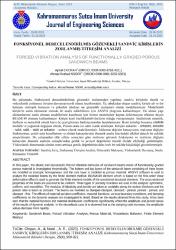Fonksiyonel Derecelendirilmiş Gözenekli Sandviç Kirişlerin Zorlanmış Titreşim Analizi
Özet
Bu çalışmada, fonksiyonel derecelendirilmiş gözenekli malzemeden yapılmış sandviç kirişlerin elastik ve
viskoelastik zorlanmış titreşim davranışı teorik olarak incelenmiştir. Üç tabakadan oluşan sandviç kirişin alt ve üst
katmanı izotropik homojen ve çekirdek tabakası ise gözenekli malzemeli olarak modellenmiştir. Modellenen
kirişlerin sonlu elemanlar metodu ile analiz edilebilmesi için ANSYS programı kullanılmıştır. Ele alınan yapı
elemanlarının sonlu eleman modellerinin kurulması için birinci mertebeden kayma deformasyon etkisine dayalı
BEAM189 elemanı kullanılmıştır. Kirişin kesit özelliklerinin üniform olduğu varsayılmıştır. Analizlerde simetrik,
üniform ve monolitik olmak üzere üç çeşit gözenek fonksiyonundan faydalanmıştır. Kesit kalınlığı boyunca elastiste
modülü ve yoğunluk değişken olarak, Poison oranı ise sabit olarak alınmıştır. Kirişler ankastre – ankastre, ankastre
– sabit, sabit – sabit ve ankastre – serbest olarak modellenmiştir. Malzeme değişim katsayısının, malzeme değişim
fonksiyonun, çeşitli sınır koşullarının ve sönüm katsayılarının dinamik analiz üzerindeki etkileri detaylı bir şekilde
araştırılmıştır. Bu çalışmadan elde edilen sonuçlara göre malzeme gözenek fonksiyonu ve malzeme değişim
katsayıları dinamik analizin sonuçlarından genlik ve periyot değerlerini önemli ölçüde etkilediği görülmüştür.
Viskoelastik durumunda sönüm oranı arttıkça genlik değerlerinin daha hızlı bir şekilde küçüldüğü gözlemlenmiştir. In this paper, the elastic and viscoelastic forced vibration behavior of sandwich beams made of functionally graded
porous material is investigated theoretically. The bottom and top layers of the sandwich beam consisting of three layers
are modeled as isotropic homogeneous and the core layer is modeled as porous material. ANSYS software is used to
analyze the modeled beams by the finite element method. BEAM189 element which is based on the first-order shear
deformation effect is used to generate the finite element models of the considered structural elements. The cross-sectional
properties of the beam are assumed to be uniform. Three types of porosity functions are used in the analysis: symmetric,
uniform, and monolithic. The modulus of elasticity and density are taken as variables along the section thickness and the
poison ratio is taken as constant. The beams are modeled as clamped-clamped, clamped - pinned, pinned - pinned, and
clamped - free. The effects of material variation coefficient, material functions, various boundary conditions, and damping
coefficients on the dynamic analysis are investigated in detail. Based on the results obtained from this study, it has been
seen that the material function and material distribution coefficients significantly affect the amplitude and period values
of the results of dynamic analysis. In the viscoelastic case, it is observed that as the damping ratio increases, the amplitude
values decrease more rapidly.

















